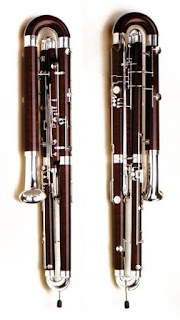The contrabassoon or double bassoon is a larger version of the bassoon sounding an octave lower. Its technique is similar to its smaller cousin, with a few notable differences:
The reed is considerably larger, at 70-75 mm in total length as compared to 53-58 mm for most bassoon reeds.
Fingering is slightly different, particularly at the register change and in the extreme high range.
The instrument is twice as long, curves around on itself several times, and is supported by an endpin due to its weight and shape rather than a seat strap. Additional support is sometimes given by a strap around the player's neck. A wider hand position is also required, as holes are less closely spaced.
There is considerably more air volume required in playing, and the instrument does not respond as quickly.
The contrabassoon has a water key to expel condensation, and a tuning slide for gross pitch adjustments.
The instrument comes in one piece (plus bocal); it does not disassemble.
With a range beginning at B♭0 (extending down a half-step to the lowest note on the piano on instruments with the low A extension), and extending just over three octaves, below middle C, the contrabassoon is the deepest available sound in most orchestras. Accordingly, the instrument is notated an octave above sounding pitch in bass clef, with tenor clef very occasionally called for in high passages. The instrument has a high range extending to middle C, but the top fifth is rarely used. Tonally, it sounds much like the bassoon except for a distinctive organ pedal quality in the lowest octave of its range which provides a solid underpinning to the orchestra. Although the instrument can have a distinct 'buzz', which becomes almost a clatter in the extreme low range, this is nothing more than a variance of tone quality which can be remediated by appropriate reed design changes. While prominent in solo and small ensemble situations, the sound can be completely obscured in the volume of the full orchestra.
History and current use
The contrabassoon was developed in the mid-17th century; the oldest surviving instrument, which came in four parts and had only three keys, was built in 1714. It was around that time that the contrabassoon began gaining acceptance in church music, and by the end of the 18th century it was making its way into British military bands. Often, it was (and still is) called upon to replace parts originally written for the contrabass sarrusophone, which had fallen out of favor for its poor intonation and tone quality. Currently, contrabassoons are made by Heckel, Fox, Wolf, Moennig, Moosman, Püchner, Adler, and Amati (and possibly others). Most orchestras use one contrabassoonist, either as a primary player or a bassoonist who doubles, as do a large number of symphonic bands and wind ensembles.
The first independent contrabassoon part (i.e., not just doubling the bassoons or string basses) was written in Beethoven's Fifth Symphony. While relatively rare, the instrument is most frequently found in larger symphonies, particularly those of Gustav Mahler, Richard Strauss, and Dmitri Shostakovich. Composers have often used the contrabassoon to comical or sinister effect by taking advantage of its clumsiness and its sepulchral rattle, respectively. Clear examples of its sound can be heard in Paul Dukas' Sorcerer's Apprentice and Gunther Schuller's concerto for the instrument. Orchestrally, the contrabassoon is featured in Maurice Ravel's Mother Goose Suite and Concerto for the Left Hand.
Example
An excerpt from the cello suites of J.S. Bach, played on a contrabassoon: contra2.ogg




